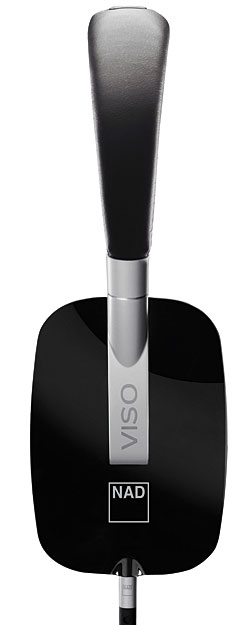NAD Viso HP50 Headphone

AT A GLANCE
Plus
Superb sound
Elegant good looks
Comfy to wear for long trips
Minus
Non-hinged headband doesn’t collapse for compact storage
THE VERDICT
NAD’s first headphone scores high on every front—style, sound, comfort, and value.
This was an easy review to write; the NAD Viso HP50 sounds as smooth as silk, with excellent detail retrieval, a big soundstage, and bass with the perfect balance of speed and low-end oomph. As a long-term NAD fan, I wasn’t surprised. The company has always made fuss-free, great-sounding, affordable gear; why would the Viso HP50 be any different?
When I delved deeper into how this headphone was born, I discovered a few twists and turns, starting with the fact that the Viso HP50 was designed by PSB Speakers’ Paul Barton, not long after he completed work on PSB’s terrific M4U series of headphones. Barton has designed some of my all-time favorite speakers, and he transitioned to headphones with surprising ease. When I spoke with Barton to get his take on how headphone design differs from speaker design, he immediately zeroed in on the fact that headphones don’t have the standing wave issues that always color the sound of his speakers in the real world. But he quickly added that headphones don’t benefit from room gain, which augments speakers’ bass balance in rooms. That’s one of the reasons why headphones will never produce the visceral feel of bass like speakers do. To help compensate for the loss, Barton tuned the Viso HP50 to have a little warmer midrange than what he went for with the M4U. I think the NAD is a more elegant-looking design than the PSBs. Barton said, “Getting into headphones is a whole new thing. It’s been a great pleasure!”
 Rather than use an off-the-shelf driver, Barton worked with other engineers to design the 40-mm drivers for the PSB and NAD headphones. The two headphones’ drivers are similar, but the tuning and internal damping had to be different to accommodate the NAD’s and PSB’s ear cups’ cavity sizes. Barton is a measurement-oriented engineer, but he road-tested the Viso HP50 by listening to prototypes on ten 16-hour flights, and his dedication paid off. These are unusually comfortable headphones.
Rather than use an off-the-shelf driver, Barton worked with other engineers to design the 40-mm drivers for the PSB and NAD headphones. The two headphones’ drivers are similar, but the tuning and internal damping had to be different to accommodate the NAD’s and PSB’s ear cups’ cavity sizes. Barton is a measurement-oriented engineer, but he road-tested the Viso HP50 by listening to prototypes on ten 16-hour flights, and his dedication paid off. These are unusually comfortable headphones.
Barton has always nailed just the right balance of testing, measuring, and listening for his designs, and that’s evident in the results he gets. He paid extra attention to maximizing sensitivity, so the Viso HP50 can play nice and loud with smartphones and portable players.
The headphone comes with two 4.2-foot cables: one with an inline iPhone-compatible mike and play/pause/answer button, the other a standard cable. The Viso HP50 weighs 8 ounces, and the headphone is available with white, black, or red ear cups. The headband isn’t hinged, but the ear cups swivel flat, so when the Viso HP50 is safely tucked away in the included carry case, it won’t take up too much room. The rectangular-shaped ear cushions didn’t completely surround my ears, but they effectively sealed out noise.
As I played through a tall stack of CDs, the thing that really stood out was how clean the HP50 sounded. Jazz pianist Jacky Terrasson’s Reach CD sounded oh-so-natural on the Viso HP50; the midrange accuracy was outstanding. A quick switchover to the Sennheiser HD 25 Aluminum on-ears pulled the soundstage in, whereas the Viso HP50 opened it up.
For my home theater auditions, I plugged the Viso HP50 into my Oppo BDP-105 Blu-ray player’s built-in headphone amp. Low-level, super-quiet details, like footsteps of people walking down the hall and the sounds of typewriters outside Don Draper’s office on my Mad Men Blu-rays were easy to hear. The Viso HP50 provided a sense of envelopment on Phantom, a Cold War tale about a Soviet submarine crew’s struggle to prevent a mad man from starting a nuclear war. The Viso HP50’s low, low bass easily reproduced the droning rumble of the sub’s diesel engines.
NAD’s on a roll: Its recently released D 3020 digital amp for 21st-century audiophiles was an unabashed hit, and now the Viso HP50 demonstrates how good a $299 full-size headphone can be.



























































